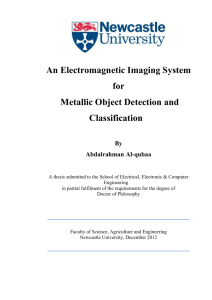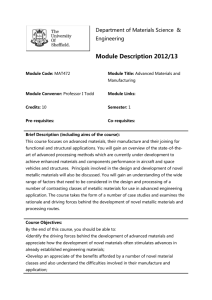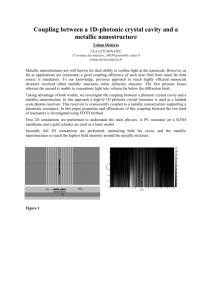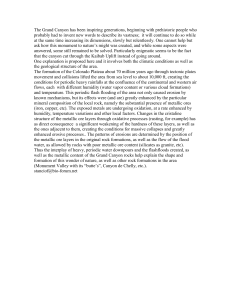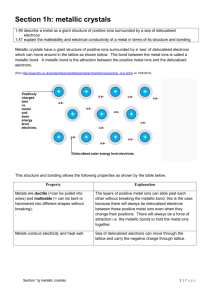metallic microlattice
advertisement
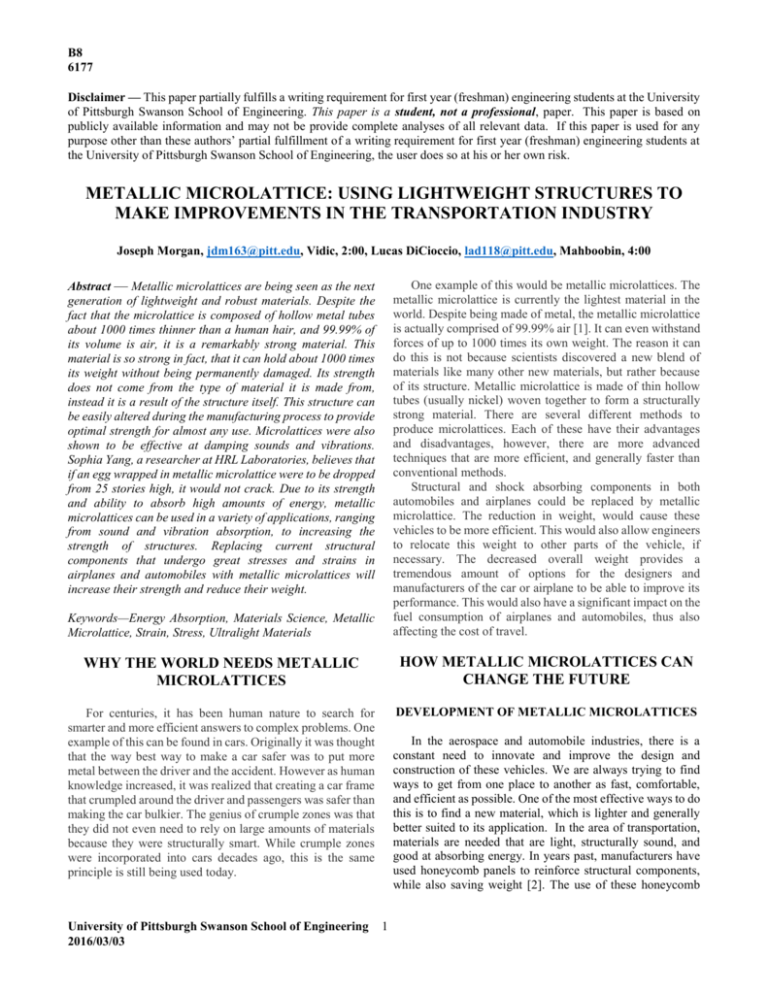
B8 6177 Disclaimer — This paper partially fulfills a writing requirement for first year (freshman) engineering students at the University of Pittsburgh Swanson School of Engineering. This paper is a student, not a professional, paper. This paper is based on publicly available information and may not be provide complete analyses of all relevant data. If this paper is used for any purpose other than these authors’ partial fulfillment of a writing requirement for first year (freshman) engineering students at the University of Pittsburgh Swanson School of Engineering, the user does so at his or her own risk. METALLIC MICROLATTICE: USING LIGHTWEIGHT STRUCTURES TO MAKE IMPROVEMENTS IN THE TRANSPORTATION INDUSTRY Joseph Morgan, jdm163@pitt.edu, Vidic, 2:00, Lucas DiCioccio, lad118@pitt.edu, Mahboobin, 4:00 Abstract — Metallic microlattices are being seen as the next generation of lightweight and robust materials. Despite the fact that the microlattice is composed of hollow metal tubes about 1000 times thinner than a human hair, and 99.99% of its volume is air, it is a remarkably strong material. This material is so strong in fact, that it can hold about 1000 times its weight without being permanently damaged. Its strength does not come from the type of material it is made from, instead it is a result of the structure itself. This structure can be easily altered during the manufacturing process to provide optimal strength for almost any use. Microlattices were also shown to be effective at damping sounds and vibrations. Sophia Yang, a researcher at HRL Laboratories, believes that if an egg wrapped in metallic microlattice were to be dropped from 25 stories high, it would not crack. Due to its strength and ability to absorb high amounts of energy, metallic microlattices can be used in a variety of applications, ranging from sound and vibration absorption, to increasing the strength of structures. Replacing current structural components that undergo great stresses and strains in airplanes and automobiles with metallic microlattices will increase their strength and reduce their weight. Keywords—Energy Absorption, Materials Science, Metallic Microlattice, Strain, Stress, Ultralight Materials One example of this would be metallic microlattices. The metallic microlattice is currently the lightest material in the world. Despite being made of metal, the metallic microlattice is actually comprised of 99.99% air [1]. It can even withstand forces of up to 1000 times its own weight. The reason it can do this is not because scientists discovered a new blend of materials like many other new materials, but rather because of its structure. Metallic microlattice is made of thin hollow tubes (usually nickel) woven together to form a structurally strong material. There are several different methods to produce microlattices. Each of these have their advantages and disadvantages, however, there are more advanced techniques that are more efficient, and generally faster than conventional methods. Structural and shock absorbing components in both automobiles and airplanes could be replaced by metallic microlattice. The reduction in weight, would cause these vehicles to be more efficient. This would also allow engineers to relocate this weight to other parts of the vehicle, if necessary. The decreased overall weight provides a tremendous amount of options for the designers and manufacturers of the car or airplane to be able to improve its performance. This would also have a significant impact on the fuel consumption of airplanes and automobiles, thus also affecting the cost of travel. WHY THE WORLD NEEDS METALLIC MICROLATTICES HOW METALLIC MICROLATTICES CAN CHANGE THE FUTURE For centuries, it has been human nature to search for smarter and more efficient answers to complex problems. One example of this can be found in cars. Originally it was thought that the way best way to make a car safer was to put more metal between the driver and the accident. However as human knowledge increased, it was realized that creating a car frame that crumpled around the driver and passengers was safer than making the car bulkier. The genius of crumple zones was that they did not even need to rely on large amounts of materials because they were structurally smart. While crumple zones were incorporated into cars decades ago, this is the same principle is still being used today. DEVELOPMENT OF METALLIC MICROLATTICES University of Pittsburgh Swanson School of Engineering 2016/03/03 In the aerospace and automobile industries, there is a constant need to innovate and improve the design and construction of these vehicles. We are always trying to find ways to get from one place to another as fast, comfortable, and efficient as possible. One of the most effective ways to do this is to find a new material, which is lighter and generally better suited to its application. In the area of transportation, materials are needed that are light, structurally sound, and good at absorbing energy. In years past, manufacturers have used honeycomb panels to reinforce structural components, while also saving weight [2]. The use of these honeycomb 1 Joseph Morgan Lucas DiCioccio panels has been effective in saving weight, however, as our world becomes increasingly conscious of our effects on the environment, manufacturers have been looking for materials or structures that could further improve the efficiency of airplanes and automobiles. By decreasing the overall weight of the vehicle, less fuel is necessary to power the vehicle. Even small decreases in weight can have a very large impact on fuel consumption over a long period of time. With so much research being done on new materials for the aerospace and automobile industries, it is no surprise, then, that a research laboratory co-owned by General Motors and Boeing discovered one such material. Researchers at HRL Laboratories first created the metallic microlattice in 2007 [3]. The reasoning behind the metallic microlattice is the exact same reasoning behind the Eiffel Tower. The symmetrical structure allows it to hold up to much larger forces than usual [4]. In some respects, the metallic microlattice is just an extremely small scale version of the Eiffel Tower. It has the same type of symmetrical truss system which gives this material its strength. Deformation forming is a process in which hexagonal or diamond shapes are punched out of a sheet of metal. The metal can then be bended at the nodes to form the lattice shape. This method can produce either tetrahedral or pyramidal shapes. To be able to bend the metal, it first needs to be softened, which is usually done by an annealing treatment. To perform an annealing treatment, the metal is heated to around fifty degrees celsius, and then is cooled at a rate of twenty degrees celsius per hour [8]. Even though the heat treating process does take several hours, this process is faster than investment casting because of the fewer number of steps in this process. The only disadvantage is the amount of material that is wasted due to perforating the metal sheet. The next conventional manufacturing process is woven metal textiles. This is a very simple technique to make microlattices. As the name implies, wires are simply woven together into the desired shape. Using this technique, virtually any arrangement or structure is feasible. Because of the simplicity of this technique, it is one of the least time consuming processes. It is also very inexpensive because there are virtually no wasted materials [7]. The only disadvantage to this material, is that as it was simply bent to the shape of the lattice, the trusses only cross over each other at the nodes. This means that their strength is slightly decreased when compared to over types of microlattice construction. Non-woven metal textiles are very similar to woven metal textiles. In this technique, layers of wires or tubes are stacked together and joined through brazing. Brazing is when the metal is melted at the joint and a filler metal is inserted and allowed to cool. When it does dry, what is left is one solid piece of metal [9]. This process, like woven metal textiles, is very cheap and fast. The difference between the two is that the non-woven textile is more limited in the possible arrangements. CONVENTIONAL MANUFACTURING PROCESSES The two main categories of manufacturing processes for metallic microlattices are the conventional and advanced methods. The conventional methods for manufacturing include investment casting, deformation forming, woven metal textiles, and non-woven metal textiles [5]. These methods are generally slower and less efficient than advanced methods. Investment casting is a process in which liquid metal is poured into a mold to create the desired structure. This process has been used for hundreds of years to create copies of metal components. The first step of this process is to create the mold itself. There are actually two different molds that need to be made. The first is created out of metal. They are usually made using a CNC milling machine, which follows a computer model to create the mold. Then, the second mold can be made. They are generally made of either wax or a volatile polymer. A volatile polymer is a type of polymer that can be melted into a liquid form. The polymer or wax is heated to convert it to a liquid form. It is poured into the metal mold, and allowed to dry. This results in a finished mold, which can be filled with the liquid metal. Once the metal has solidified, the outer mold is removed, leaving only the desired material. The problem with this method is that it is very time consuming, expensive and wastes several different intermediate materials [6]. Since the walls of the microlattices are so thin (around 100 nanometers), the mold also has to be very close together. At these thicknesses, it is very difficult to make the liquid metal flow through the whole mold. Therefore, the smallest density currently achievable with this technique is around two percent [7]. While this is still a very low density, it is not as low as manufacturers would like it to be in some circumstances. ADVANCED MANUFACTURING PROCESSES In addition to the conventional methods of manufacturing, there are also some more advanced methods. These include selective laser melting, electron beam melting, and selfpropagating photopolymer waveguide technique. In general, these advanced methods are faster, but more expensive than the conventional methods. Selective laser melting and electron beam melting are essentially the same techniques. Both of these techniques are forms of additive manufacturing. This means that they are built by adding layer upon layer of metal powder. The powder is then melted either by a laser or electron beam to form the solid microlattice structure. Using additive manufacturing, there is virtually no wasted materials, because the metal powder is first deposited in the exact structure and orientation of the finished microlattice. Therefore, there is no need to cut off excess material like in investment casting or deformation forming [7]. 2 Joseph Morgan Lucas DiCioccio The final method for producing metallic microlattices is called the self-propagating photopolymer waveguide technique. This is the technique that the researchers at HRL Laboratories used to create their microlattice in 2007. The basic idea of this technique is to shine ultraviolet light on a photopolymer, causing it to solidify. The photopolymer used by T.A. Schlaeder et al, was a thiol-ene liquid monopolymer [10]. To create the microlattice shape, the light is shone at a specific angle through a grid. This prevents the light from hitting certain areas of the photopolymer, thus keeping it as a liquid, while causing the areas struck by the light to solidify. The result is the interconnected microlattice shape. This template can then be coated in a metal such as nickel using a process known as autocatalytic electroless plating. The electroless plating process allows very specific amounts of nickel to be deposited on the polymer. This is because the thickness of the nickel coat depends on the length of time it is allowed to react in the nickel solution. Once the metal coat has been added, the polymer can be dissolved by putting it in a basic solution. This leaves behind the finished metallic microlattice [4]. This is one of the most popular techniques to produce microlattices, as it is very easy to produce many different orientations and geometries of microlattices. The problem with simply comparing these three values to those of other materials, is that microlattices would not just be used on their own. In practice, metallic microlattices would be made into sandwich panels similar to honeycomb panels that are currently used in the aerospace and automobile industries. There has not been enough public testing of simple microlattice arrays to honeycombs with reliable data, for example. Therefore, we can simply analyze the properties of microlattices, or compare the strength of these materials per unit mass. By comparing the materials’ strength per mass, we are able to see a better representation of how strong the microlattices are even though they are so light. In these stress versus strain curves, the highest peak signifies the first compression test. In figure 4A, six compressions were performed. The first peak represents the point where the microlattice begins to buckle at a few locations. After this peak, the stress decreases slightly which is representative of the whole microlattice compressing and absorbing the pressure evenly across the material. The curve then decreases sharply, back to its original position. In tests two through six, the curve never reaches a peak like in test one, instead, there is a more gradual increase. This is because in a sense, the microlattice has already been “broken in”, so that it will flex under a smaller force. This happens with all materials, but what is special about microlattices is that there is very little degradation between the second and sixth tests. This is also shown in figure 4B. This shows how different physical properties of the microlattice change over the course of the six cycles. The maximum stress experienced by the microlattice stays relatively constant throughout the test. The Young’s Modulus, which is very similar to the compressive modulus, decreases after the first trial, but then stays constant. This is the same pattern for the yield stress, and energy loss. Energy loss is a very important value for determining the effectiveness of microlattices and other materials designed to absorb impacts. The amount of energy lost is equivalent to the amount of energy that the microlattice absorbed. While having a high energy loss is desirable, it is perhaps even more desirable to have a consistent energy loss value over the course of many compressions. This is important because automobiles and airplanes are exposed to repeated impact over the lifetime of these vehicles. If shock absorbers or structural components broke after only a few impacts, the cost of maintenance would be completely impractical. Figure 5 shows how microlattices compare in terms of energy absorption capacity per gram to honeycomb materials. This shows that depending on the specifications of the microlattice, they can be equally as efficient and even more efficient that honeycomb panels. In order for these materials to be used, the original shape also has to be maintained even if they are exposed to large forces. Researchers at HRL Laboratories have found that when nickel microlattice is compressed to half of its original height, the microlattice recovers nearly completely. It only results in a residual strain of two percent, and recovers to its original shape. ENERGY ABSORPTION The main property that researchers at HRL Laboratories wanted to achieve in their search for a new material was the ability to absorb energy, while still being able to retain its original shape after an impact. To quantitatively analyze energy absorption properties of the microlattice, we will look at three different values change as the dimensions of the microlattice change. We will also compare these values to those of other materials. The compressive modulus, E, is a relationship between the amount a material has been compressed, also known as the strain, and the force per unit area, or the stress. The higher the compressive modulus, the larger the force needed to deform the material. Also, the more a material is deformed by a given force, the smaller the compressive modulus is. In data table 1, all of the microlattice samples are made out of nickel. We cannot accurately compare the compressive moduli for solid nickel and nickel microlattices, The compressive strength is the maximum stress a material can withstand before permanently deforming. Therefore the compressive strength can be found using the formula: =FA where F is the force, and A is the crosssectional area. A larger compressive strength signifies that the material can absorb a large force, thus it can also absorb a large amount of energy. The residual strain is the amount that the material was permanently deformed as a result of the force. To find the residual strain, the change in height of the microlattice is divided by the original height: =LL. The change in height is the difference between the initial height and the height after a full compression cycle has been performed. 3 Joseph Morgan Lucas DiCioccio There are two main theories to explain why exactly microlattices are so good at absorbing energy despite their extremely low density. The possible reason is because as the microlattice compresses, the trusses bend, buckle, and in extreme cases, may snap. Even though the structure is slightly weakened when this happens, it also absorbs a lot of energy in the process. The second reason is because of the force of friction caused by each truss rubbing against each other. The former is more likely because for large arrays of microlattices, each truss is supported by those around it, which allows them to undergo a controlled and stable compression. Metallic microlattices are very good candidates for structural components and other components that need to absorb vibrations or impact. This is because of the combination of their durability, energy absorption, and resilience to permanent damage. kilo-pascals to pounds per square inch, using the conversion rate of 1 kpa = .145 psi, we were able to compare the the compressive strength of metallic microlattices to the compressive strengths Hexcel’s honeycombs. Viewing the data side by side shows that the strongest metallic microlattice is stronger than most of the aluminum alloy honeycombs. According to the information given in table 1, the compressive strength of microlattice sample A is 8510 kPa, when converted to psi (8510 kpa * .145) exhibits a compressive strength of 1234.2 psi. When comparing the strength of to the compressive strengths of Hexcel honeycombs the data shows that only two honeycomb formations manage to have a higher compressive strength than the tested metallic microlattice. This shows that for the most part metallic microlattices are just as strong as or even stronger than aluminum honeycombs [12]. In addition to being generally stronger than honeycombs, metallic microlattices are also more customizable than honeycomb products. While more dense microlattice can be built to be stronger than honeycombs while sacrificing weight, metallic microlattices can also be configured to be the lightest material in the world, sacrificing strength. By adjusting the hollow tube thickness, strut length and strut angle, metallic microlattices can fit almost any need. When using the self-propagating photopolymer technique, all that needs to be done in order to adjust the thickness or angle of the trusses is to adjust the angle that the ultraviolet light hits the polymer. This is a very simple adjustment that is also very inexpensive. This makes them the ideal to replace Hexcel’s honeycomb and other honeycomb products in airplanes. While honeycombs are rigid in their design, metallic microlattices can be fine-tuned to the exact specifications required of the job. This will allow aircraft manufacturers to customize the strength and density of their aircraft’s structural components, using denser microlattices in areas that require higher energy absorption and lighter microlattices in areas that do not need to absorb enough energy. Designers can build their own microlattice to be as strong or as light as necessary. While metallic microlattices are a new technology it is clear that they will soon make structural components like honeycombs obsolete. THE ROLE OF METALLIC MICROLATTICES IN THE AEROSPACE INDUSTRY One of the biggest problems in the aerospace industry is weight management. The most obvious obstacle to airplanes is gravity. To fight gravitational forces airplane manufacturers try to create lighter and lighter airplanes. A large challenge for airplane designers is finding the right balance between lightweight and strong materials, making the plane light enough to fly and strong enough to stay stable. Until recently, the most efficient materials to use for paneling in airplanes were honeycomb panels. Honeycomb panels are made of an inner insulating layer shaped in a honeycomb pattern with two layers of metal paneling on either side. Honeycomb panels are extremely efficient in situations where it will have to absorb vibrations. However, metallic microlattices might soon replace honeycomb paneling in planes. Metallic microlattices are not only lighter than honeycomb panels, but microlattices are also more than capable of absorbing energy. Energy absorption in planes is important to keeping passengers comfortable. Planes shake and tremble when varying air pressures lead to turbulence that absorbs more energy, will absorb more vibrations, leading to less vibrations inside the cabin. The weight of the metallic microlattice also makes it an ideal choice for any component on an aircraft that requires an ultralight material. Science Magazine states that for a material to be ultralight, it must have a density of 10 mg/cc or less [11]. While metallic microlattices are not always made to be ultralight materials, they can be made to be extremely lightweight. According to Table 1, located above, metallic microlattices can be made to be as dense as only .017 mg/cc, making this particular type of metallic microlattice one of the lightest materials in the world. One structural material that is currently being used in airplanes are HexWeb honeycomb cells. As listed on the parent company Hexcel’s website, HexWeb honeycombs are used in 19 key components of airplanes from ailerons to stabilizers. However, by converting the compressive strength values for the metallic microlattices tested on table one from ADVANCEMENTS IN THE AUTOMOBILE INDUSTRY As with planes, an easy way to increase efficiency is to conserve weight. Automobiles, however, are exposed to many more impacts than airplanes, because of their constant contact with the ground, as well as more frequent high energy impacts with other cars. This means that metallic microlattices could also increase the safety of cars [13]. Because metallic microlattices are so good at absorbing high amounts of energy, they would fit well in areas such as the bumpers as well as structural components. In addition to making cars safer metallic microlattices could also be used to create a more comfortable ride. Placing microlattices underneath seat 4 Joseph Morgan Lucas DiCioccio cushions and in various other places in the interior could create an extremely smooth ride. In addition to these functions, Hexcel honeycombs, a product with similar applications to metallic microlattice, can be used to protect drivers and passengers in accidents. As in the aerospace industry, metallic microlattices could prove to be just as effective as and more efficient than the Hexcel honeycomb. be used to dampen noise and vibrations in addition to being a lightweight structural component. Because they are so light and good at absorbing energy, there has also been discussion of using microlattices in football and crash helmets. Although there have been no such products incorporating microlattices yet, they would be a good fit. While metallic microlattices may not be a flashy new invention, they are important none the less. Stronger and lighter materials will not only let us make existing technologies more efficient, but will be necessary to the inception of creations that have not even been thought of yet. As the amount of research on the applications of metallic microlattices increases in the future, the cost of producing microlattices will decrease. This is because the methods for producing them will become more and more efficient, replacing older and more wasteful techniques. This will further incentivize transportation companies to make the transition away from honeycomb panels, to metallic microlattice sandwich panels. Because the manufacturing of metallic microlattices results in little to no waste, metallic microlattices are not only a smart option, but an economical as well. However the benefits of metallic microlattices also surpass just manufacturing, since incorporating metallic microlattices into vehicles makes them more efficient and in turn, makes them require less energy or fuel to use. AFFCTS OF METALLIC MICROLATTICES ON THE ENVIRONMENT AND ECONOMY Raw materials such as metal ores are becoming increasingly harder to attain. Therefore it makes sense to try to conserve as much materials as possible. Because over 99% of the metallic microlattice is air, very little raw materials are needed to create it. This also lowers manufacturing costs as well as pollution that results from extracting ores from the earth [5]. Metallic microlattices manufacturing results in such little manufacturing waste it is estimated that manufacturing titanium microlattices instead of blocks of raw material could extend the longevity of Australia’s titanium reserve tenfold. However the environmental impact of metallic microlattices far exceeds the amount of metals used to create the material itself. By incorporating metallic microlattices into the design of airplanes, these vehicles can be made to weight much less. Lighter airplanes and cars are able to be more fuel and energy efficient. In airplanes, even small reductions in weight can have a large impact on the fuel economy. According to Lufthansa German airlines, even small reductions in weight can lead to large overall savings. Lufthansa airlines claimed that shedding one kilogram on all of their aircrafts, the airline managed to save 30 tons of fuel [14]. Replacing current sound and energy insulators and sandwich panels with microlattices could lead to a significant reduction in weight and incorporating microlattices into every plane in a fleet could not only save fuel, but money for the airlines. Microlattices could also replace the already commonly used honeycomb fillers such as Hexcel honeycomb. In addition to being strong and lightweight, metallic microlattices are also beneficial for sustainability. METALLIC MICROLATTICES: THE FUTURE OF TRANSPORTATION While metallic microlattices are a new creation, it is clear they will have a large impact on the transportation people use every day. Despite being the lightest material ever created, metallic microlattices are surprisingly strong and are able to resist large amounts of stress and maintain their shape. This new material can be used in almost any situation that requires a lightweight structural component. Another benefit of metallic microlattices is that it does not require many raw materials to make. Considering that metallic microlattices can be built to be 99.99% air, they require an incredibly small amount of alloy to develop. Factor in the number of different manufacturing processes that create little to no material waste, metallic microlattices are one of the most sustainable materials on the planet. The weight reduction is not without effect either. Using the ultralight microlattices in vehicles such as airplanes and automobiles will cut down on the weight of the vehicle, increasing its efficiency. Despite being the lightest material ever created, metallic microlattices can actually withstand large stresses and strains and can even support 1000 times its own weight. This is especially remarkable because of their consistency and dependability over time. After the microlattice is “broken in”, its properties will stay constant over time even when subject to large forces. The extreme weight saving possibilities provided by the use of microlattices allow engineers and designers more options to further improve the performance and efficiency of vehicles THE IMPORTANCE OF METALLIC MICROLATTICES IN THE TRANSPORTATION INDUSTRY Metallic microlattices stand to make a rather large impact on the transportation industry. Their sheer number of applications makes them useful in almost any situation. In planes, metallic microlattices could replace current sandwich panel fillers like Hexcel, or other honeycomb panels. In cars, metallic microlattices can be incorporated to absorb energy or to help protect the driver and passengers from a collision. Metallic microlattices will be able to reduce the weight of any structure they are used in and will increase their efficiency. In addition to being lightweight, metallic microlattices are able to absorb large amounts of energy, which means they can also 5 Joseph Morgan Lucas DiCioccio Metallic microlattices are an example of structural engineering on the microscopic scale, that will help to reduce both the cost of travel, and its environmental impact. 6 Joseph Morgan Lucas DiCioccio APPENDIX Figure 1 [7] This figure shows the steps of deformation forming. Figure 2 [5] This shows the layers of metal powder before it is melted either by a laser or electron beam used to create microlattices through advanced processes. 7 Joseph Morgan Lucas DiCioccio Figure 3 [10] This figure shows the steps for the self-propagating photopolymer waveguide technique. Figure 4 [10] This figure shows the stress strain curves for three different microlattices. 4A is the curve for a microlattice with a density of 14 mg/cc. 4B shows how different physical properties change after six compressions for the microlattice in 4A. 4C has a density of 1 mg/cc, and 4D has a density of 43 mg/cc. Table 1 [15] 8 Joseph Morgan Lucas DiCioccio This table includes values for compressive strength, compressive modulus and residual strain for several different microlattice samples. Figure 5 [16] This graph shows the energy absorption capacity of several different microlattice shapes as well as honeycombs. Figure 6 [17] This figure compares the impact energies of several aluminum microlattices to an aluminum honeycomb panel. 9 Joseph Morgan Lucas DiCioccio [14] “Fuel Efficiency at the Lufthansa Group.” (2012). Lufthansa Group. (online article). https://www.lufthansagroup.com/fileadmin/downloads/en/L H-fuel-efficiency-0612.pdf [15] T.A Schaedler, A. Torrents, et al. (2012). “Characterization of nickel-based microlattice materials with structural hierarchy from the nanometer to millimeter scale.” Acta Materialia. (online article). DOI: 10.1016/j.actamat.2012.03.007 [16] G. Kooistra, V.S. Deshpande, H. N. G. Wadley. “Compressive Behavior of Age Hardenable Tetrahedral Lattice Truss Structures Made From Aluminum.” (2004). Acta Materialia. (online article). https://www.researchgate.net/publication/22270060 8_Compressive_behavior_of_age_hardenable_tetrahedral_la ttice_truss_structures_made_from_aluminium [17] R. A. W. Mines, S. Tsopanos, Y. Shen, et al. “Drop Weight Impact Behavior of Sandwich Panels with Metallic Microlattice Cores.” (2013). International Journal of Impact Engineering. (online article). http://www.sciencedirect.com/science/article/pii/S0734743X 13000912 REFERENCES [1] “Microlattice: Lightest. Metal. Ever.” (2015). Boeing. (video). http://www.boeing.com/features/2015/10/innovationlightest-metal-10-15.page [2] “Metal Microlattice.” (2015). Rex Research. (online article). http://rexresearch.com/yangmicrolattice/yangmicrolattice.ht ml#WO2014137924 [3] “HRL Announces Extraordinary New Lightweight Materials.” (2007). HRL Laboratories. (online article). http://www.hrl.com/hrlDocs/pressreleases/2007/prsRls_0710 29.html [4] Mark Wilson. (2012). “Building Ultralight Lattices.” Physics Today. (online article). DOI: http://dx.doi.org/10.1063/PT.3.1385 [5] Golam Rashed, et al. (2014). “An Overview on The Structure and Applications of Metallic Microlattices.” The University of New South Wales. (presentation). http://www.compositesaustralia.com.au/wpcontent/uploads/2014/04/Golam-Rashed.pdf [6] “Investment Casting.” (2015). Bimac. (online article). http://bimac.com/assets/pdfs/investment-casting-process.pdf [7] M.G. Rashed, Muhamud Ashraf, R. A. W. Mines, Paul J. Hazell. “Metallic Microlattice Materials: A Current State of the Art on Manufacturing, Mechanical Properties and Applications.” (2015). iMechanica. (Online Article) http://imechanica.org/files/Metallic%20microlattice%20mat erials.pdf [8] “Softening: Annealing.” (2015). eFunda. (online article). http://www.efunda.com/processes/heat_treat/softening/annea ling.cfm [9] “Brazing and Soldering.” (2015). ESAB. (online article). http://www.esabna.com/euweb/oxy_handbook/589oxy19_1. htm [10] W.B Carter, T.A Schaedler, A.J. Jacobsen, et al. (2011). “Ultralight Metallic Microlattices.” Science. (print article). Vol. 334, Issue 6058 pp. 962-968 [11] H.M. Doss. (2015). “Ultralight Lattices.” American Physical Society. (online article). http://www.physicscentral.com/explore/action/microlattice.c fm [12] “HexWeb Honeycomb Attributes and Properties.” (1999). Hexcel Composites. (online article). http://www.hexcel.com/Resources/DataSheets/Broc hure-DataSheets/Honeycomb_Attributes_and_Properties.pdf [13] “Microlattice: How Revolutionary Metallic Structures Are Benefitting Global Manufacturing.” (2013). Institution of Mechanical Engineers. (online article). http://www.imeche.org/news/institution/all/2013/02/28/micr olattice-how-revolutionary-metallic-structures-arebenefiting-global-manufacturers ADDITIONAL SOURCES Joshua Buck. (2015). “NASA Selects Proposals for UltraLightweight Materials for Journey to Mars and Beyond.” NASA. (online article). http://www.nasa.gov/press/2015/april/nasa-selectsproposals-for-ultra-lightweight-materials-for-journey-tomars-and G. Evans, M. Y. He, et al. “Concepts for Enhanced Energy Absorption Using Hollow Microlattices.” (2010). International Journal of Impact Engineering. (online article). http://dx.doi.org/10.1016/j.ijimpeng.2010.03.007 Kristen Hall-Geisler. (2013). “Micro-lattice Metal: The Future of Lightweight Cars?” How Stuff Works. (online article). http://auto.howstuffworks.com/fuelefficiency/vehicles/micro-lattice-metal1.htm Chae-Hong Lim, Insu Jeon, Ki-Ju Kang. (2009). “A New Type of Sandwich Panel With Periodic Cellular Metal Cores and Its Mechanical Performances.” Materials & Design. (print article). Vol. 30 pp. 3082-3093 M. Meo, A.J. Morris, et al. (2003). “Numerical Simulations of Low-velocity Impact on an Aircraft Sandwich Panel.” Composite Structures. (print article). Vol. 62 pp. 353360 R. Mines, S. Tsopanos, et al. “On the Performance of Micro Lattice Structures as Core Materials in Sandwich Panels Subject to Low Velocity Impact.” (2009). International Comittee on Composite Materials. (online article). http://iccmcentral.org/Proceedings/ICCM17proceedings/Themes/Appli 10 Joseph Morgan Lucas DiCioccio cations/SANDWICH%20STRUCTURES/B6.1%20Mines.p df T. A. Schaedler, C. J. Ro, A. E. Sorensen, et al. (2014). “Designing Metallic Microlattices for Energy Absorber Applications.” Advanced Engineering Materials. Vol. 16 pp. 276-283 ACKNOWLEDGEMENTS We would like to thank our parents for funding our college research. In addition, we would like to thank our writing instructor Amanda Brant, our co-chair Kaitlin Keene, our professional chair, Michael Elisco, for reviewing our work thus far and David Nero for helping us analyze data. 11
